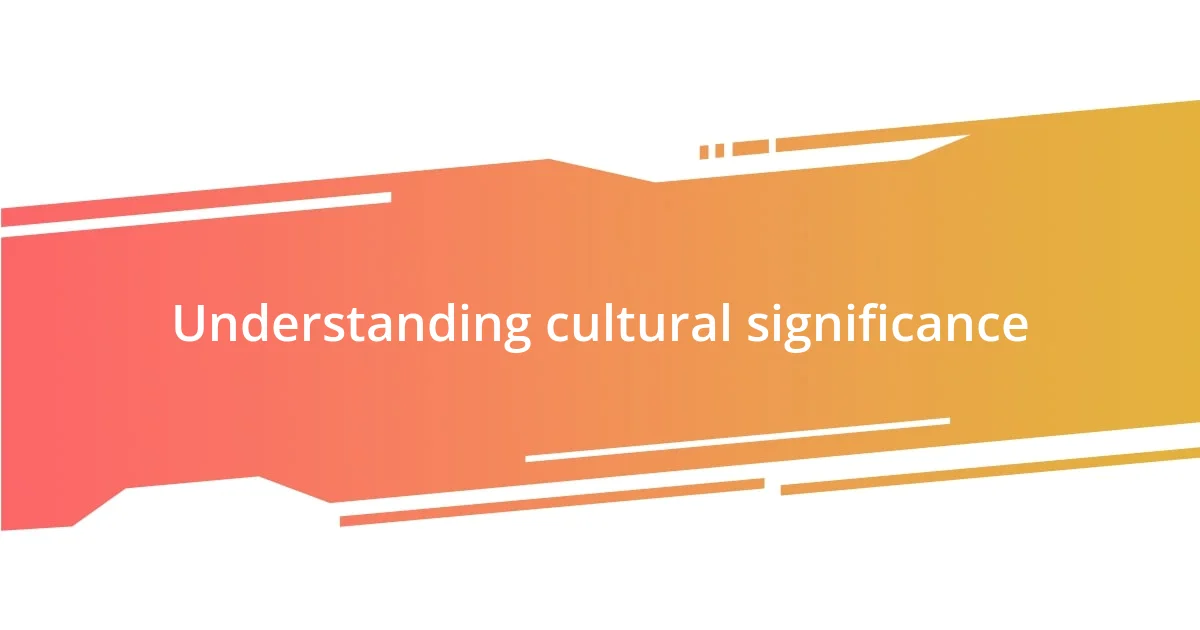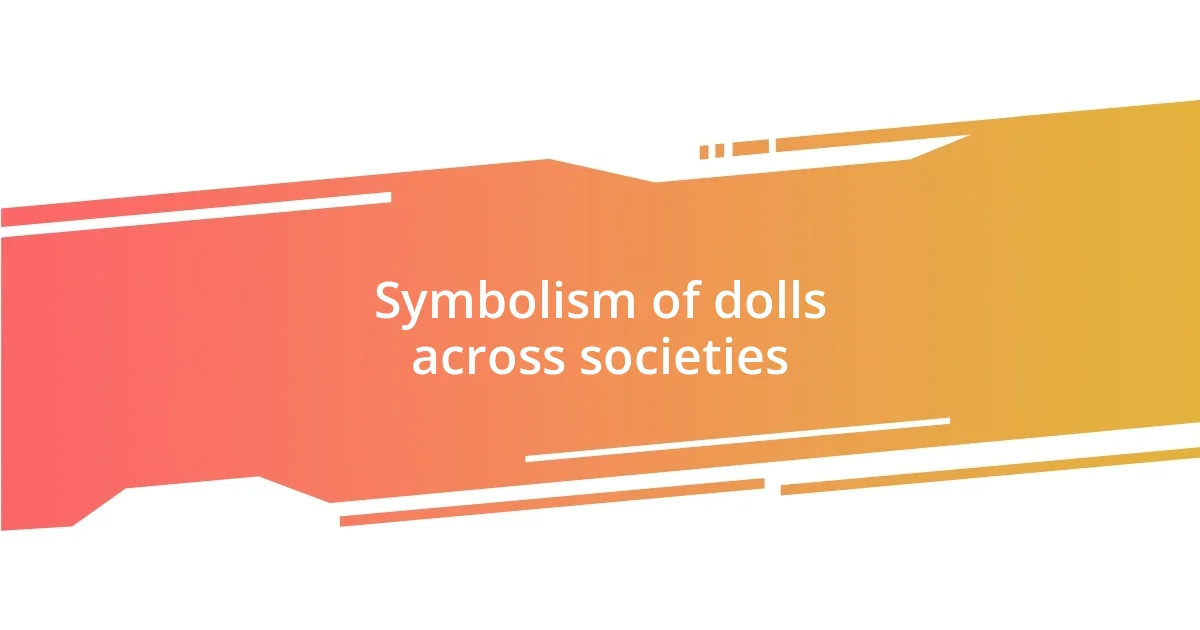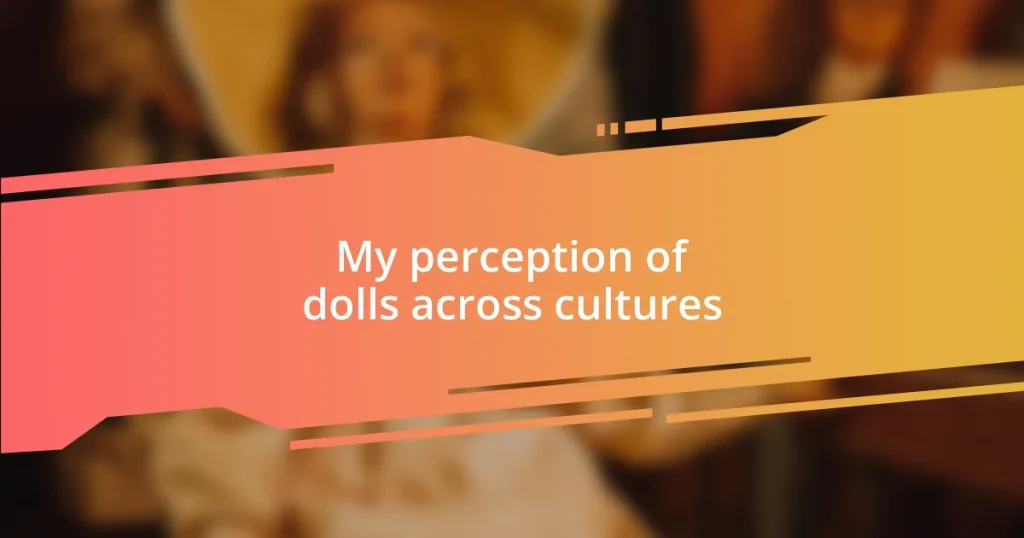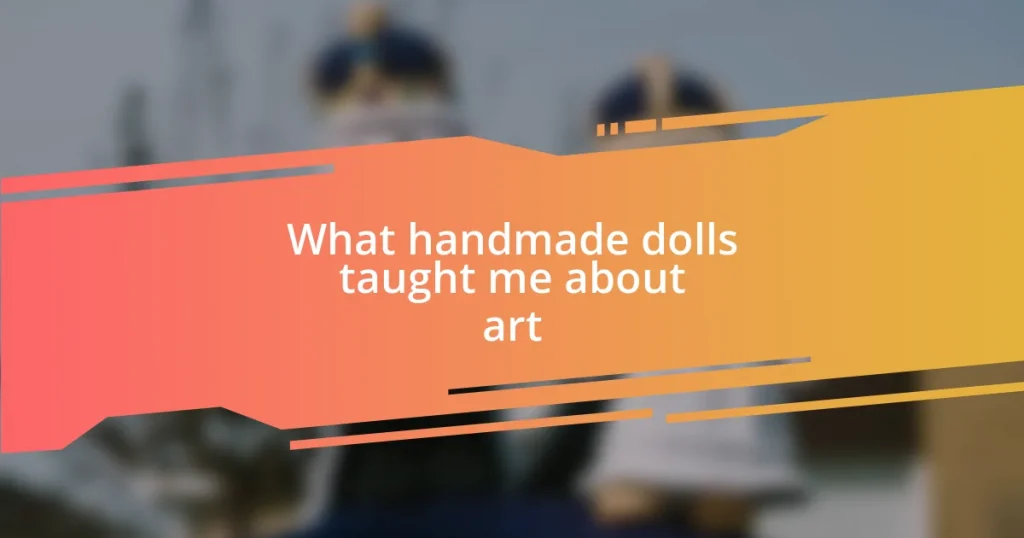Key takeaways:
- Dolls serve as cultural vessels, reflecting diverse traditions, values, and historical narratives across different societies.
- They play a crucial role in child development by promoting imaginative play, emotional intelligence, and nurturing behaviors.
- Modern interpretations of dolls embrace inclusivity and sustainability, illustrating how they adapt to contemporary societal concerns and technological advancements.

Understanding cultural significance
Dolls have always fascinated me, not just as toys but as vessels of cultural expression. Growing up, my grandmother gifted me a handmade doll from her childhood in Mexico. It was adorned with vibrant colors and intricate clothing that told a story of her heritage. I often wonder, how many children across the globe hold dolls that carry the whispers of their ancestors’ traditions?
In Japan, the significance of dolls transcends mere playthings, transforming into symbols of protection and good fortune during festivals like Hinamatsuri. The delicate craftsmanship behind each Kokeshi doll tells tales of regional folklore, capturing the essence of where they originated from. I remember visiting a doll-making workshop where artisans shared not just techniques but the emotions tied to their creations—how does one truly convey culture through mere objects?
Interestingly, in some African cultures, dolls serve as vital educational tools, teaching children about community roles and social values. I recall playing with a beautifully carved wooden doll during a cultural fair, feeling a sense of connection to stories of resilience and strength. What if we viewed dolls not just as toys, but as storytellers, bridging generations and cultures?

Historical context of dolls
Dolls have an ancient lineage, with some of the earliest known examples dating back to around 2000 BCE in ancient Egypt. Those early dolls, often made from materials like wood or cloth, were not simply for play; they served spiritual or ritualistic purposes, reflecting the values and beliefs of their time. When I discovered an exhibition showcasing these artifacts, I felt a deep connection to children thousands of years ago who might have felt the comfort and companionship of their own dolls.
In contrast, during the Renaissance, dolls evolved into exquisite collectibles that mirrored the fashion of contemporary society. Made from luxurious fabrics, they became status symbols, allowing wealthier families to showcase their social standing. It struck me how a simple doll could encapsulate societal trends and aspirations—what a fascinating commentary on human nature! Seeing these ornate dolls in a museum made me ponder how they sparked creativity and storytelling in children and adults alike.
Fast forward to today, and dolls have become global phenomena, each infused with cultural significance that varies from one region to another. In my travels, I’ve encountered unique dolls—from the Russian Matryoshka, or nesting dolls, symbolizing family bonds, to the American Barbie that evolved with changing gender roles. Each encounter ignites a little spark of curiosity in me: how do these cultural interpretations inform our understanding of identity and belonging?
| Culture | Historical Context |
|---|---|
| Ancient Egypt | Early dolls served spiritual and ritualistic purposes, reflecting ancient beliefs. |
| Renaissance Europe | Dolls became luxurious collectibles that mirrored fashion and social status. |
| Modern Global Context | Contemporary dolls embody diverse cultural narratives, shaping identity and belonging. |

Dolls in different cultures
Dolls in various cultures tell rich stories that reflect the values and traditions of their people. In India, for example, the Guddu dolls, made for the festival of Dussehra, symbolize the triumph of good over evil. I still recall attending a Dussehra celebration, where these colorful dolls were paraded to convey significant life lessons to children. The moment left me in awe of how playful objects could convey profound morals, encouraging dialogue about right and wrong.
- Japanese Kokeshi Dolls: Often crafted in wood, these dolls represent different regions and are thought to bring good luck.
- Russian Matryoshka Dolls: Nesting dolls that symbolize family and the idea of continuity across generations.
- South African Izikhothane Dolls: Used for educational purposes, they illustrate social values and roles within the community.
- Guatemalan worry dolls: These tiny handmade dolls are given to children to help alleviate fears and anxieties, reflecting a rich cultural tradition of storytelling through art.
Exploring the world of dolls across cultures reveals how they often encapsulate communal values, historical narratives, and artistic expression. In Mexico, the Day of the Dead features unique dolls dressed in traditional clothing, celebrating and honoring the memories of loved ones. I vividly remember creating my own sugar skull doll during a workshop, which not only connected me with my heritage but also imbued me with a sense of belonging. It’s fascinating how these seemingly simple objects—dolls—can evoke such deep emotions and preserve cultural wisdom.

Symbolism of dolls across societies
Dolls are more than just toys; they often carry rich symbolism that can vary dramatically across cultures. Take the African Nkisi dolls, for example, which are believed to hold spiritual powers and are used in healing rituals. The moment I first saw one in a local art gallery, I felt an overwhelming sense of respect and curiosity. How could something so small encapsulate such profound beliefs? This made me reflect on the power of intention behind the creation of these dolls.
In many cultures, dolls serve as representations or reminders of familial ties and traditions. For instance, the traditional Hispanic “muñeca” signifies maternal love and family bonds, often passed down through generations. I distinctly remember my grandmother gifting me one when I was a child, and it instantly became a cherished possession. Every stitch told a story, prompting me to ask—what stories do our dolls hold? They remind us of our roots, unspoken yet deeply felt.
Moreover, the different ways dolls embody societal values is quite striking. In many Indigenous cultures, dolls also serve a pedagogical role, teaching children about their heritage and customs. When I participated in a crafting workshop that focused on making traditional dolls, I encountered this firsthand. It was enlightening to realize that each handmade doll was not just a craft but a cultural lesson in identity and history. This experience left me pondering: how can something so simple help shape our understanding of ourselves and our communities?

Dolls and child development
Dolls play a significant role in a child’s developmental journey, often acting as tools for imaginative play. Engaging with dolls allows children to explore emotions and social situations in a safe environment. I once observed a friend’s daughter, deeply immersed in her play, negotiating roles and narrating stories that reflected her everyday experiences. It struck me how crucial these moments are for emotional intelligence—children learn empathy and problem-solving without even realizing it.
Moreover, dolls can serve as powerful cultural artifacts that introduce children to various traditions and beliefs. I remember when my niece received a set of international dolls, each representing a different culture. The experience sparked a conversation about diversity and acceptance, often leading her to ask questions about customs from around the world. This kind of engagement fosters a sense of curiosity and appreciation for others, laying the groundwork for respectful social interactions as she grows.
Additionally, the act of nurturing a doll can parallel how children learn to care for others. When my son received a soft doll for his birthday, I noticed how he instinctively wanted to feed, change, and cuddle it. This nurturing behavior not only provided him with a sense of responsibility but also demonstrated how children’s play can mimic real-world relationships. Isn’t it amazing how something as simple as a doll can contribute to essential life skills? Each of these interactions shapes a child’s understanding of care and connection, enriching their development in profound ways.

Modern interpretations of dolls
Dolls today are reimagined in a way that transcends their original purpose. I remember walking through a local artisan market and stumbling upon a stall that showcased eco-friendly, handmade dolls. They were not just toys, but powerful statements about sustainability and the environment. Isn’t it fascinating how these modern interpretations can reflect pressing societal concerns through something traditionally seen as playtime?
In recent years, I’ve noticed a surge in dolls designed to embrace diversity and inclusivity. A few months ago, I stumbled upon a line of dolls that celebrated different body types, abilities, and backgrounds. It truly struck a chord with me, as it represents a shift towards teaching children that beauty and worth come in many forms. When I held one of those dolls, I thought about the messages we send our young ones and how important it is for them to see themselves represented.
What’s even more interesting is how technology has influenced modern dolls. With the rise of interactive dolls that can engage children through conversations and responses, play has taken on a new dimension. My niece recently received a smart doll that could tell stories, which sparked her imagination in ways I’d never seen before. I can’t help but wonder: what impact will this blend of technology and traditional play have on future generations? It seems we are on the cusp of a transformative era in how dolls function in our lives, blending nostalgia with innovation.

Personal reflections on dolls
Reflecting on my own childhood, I can clearly recall the joy I felt when I played with my favorite dolls. They were more than just toys; they felt like my companions during countless imaginative adventures. I often wonder if those simple moments of play helped lay the foundation for my storytelling abilities later in life. Did I ever realize the profound impact those experiences would have on nurturing my creativity?
As I explore the cultural significance of dolls across different societies, I find myself intrigued by the stories they tell. There was a time when I visited a cultural fair, and a vendor showcased beautifully crafted dolls from various traditions. Each one seemed to whisper tales of heritage and identity. I still remember how discussing their meanings with the vendor opened my eyes to the cultural values and narratives they encapsulated. It was a poignant reminder that play can be a window into understanding the world around us.
More recently, I had the opportunity to gift a handmade doll to a friend’s daughter. Watching her excitement and the way she named the doll after a character from her favorite storybook left me feeling nostalgic. It dawned on me that this simple act of gifting not only nurtured her imagination but also created a sentimental connection. Isn’t it fascinating how dolls, in their myriad forms, can bridge generations and experiences, fostering connections that enrich our lives?













